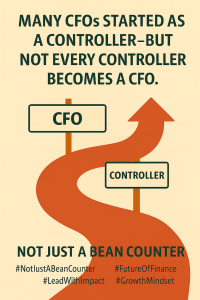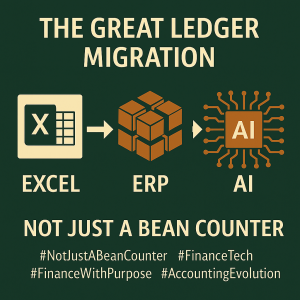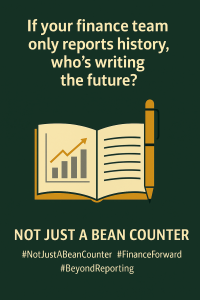Accounting is no longer just about reporting what happened—it’s about shaping what’s next. This time we quickly explore how accountants can become strategic leaders, partnering across functions, driving key performance insights, and helping guide the organization’s future direction.
From Scorekeeper to Strategist
Accounting professionals today should not just report on the numbers. We should be helping define what they should be. We should be deeply involved in strategic planning, budgeting, and forecasting that guide the company’s long-term direction. We should have “a seat at the table” when financial decisions are being made. It can no longer be “just count the beans.” Accounting professionals can be the key to unlocking the potential of a company. Executives know how to govern, operations personnel know how to operate, HR handles people, Legal manages compliance…Accounting professionals should be the power lines between all these departments because we understand process. We should understand the business, we understand risk. We understand what HAS happened and need to develop the skills to discuss what WILL happen.

Embrace a forward-looking mindset
Yes, accounting has been described as historians. For so long, it has been about “counting the beans” and what has happened in the past. However, for accountants and the accounting profession to evolve, we must start looking into the future.
CFOs and other C-Suite executives rely on BOTH historical and forward-looking financial decisions to make decisions about a wide range of strategic, operational and investment decisions, including resource allocations.

Decisions based on historical information includes performance evaluation of a business or business unit profitability and historical trends, budget vs. actual reviews that analyze variances to understand any gaps in execution, audit and compliance to support any regulatory filings and internal control assessments, and benchmarking of results against competitors or industry KPIs. Reading all of these, the theme is consistent. It tells the story: where we have been. This is not anything that can change.
However, much of what the C-Suite considers is: where are we going? This is where the forward-looking mindset comes in. Where we have been is a great starting point for where we are going. Historical trends can be used to project the future. However, this is only part of the story. Forward looking decision areas include strategic planning including growth targets, resource allocation and expansion strategies, capital allocation including M&A, Capex and R&D, forecasting liquidity needs, modeling downside scenarios, pricing strategy and workforce planning.
Leverage Technology & Data Analytics

As discussed above, accounting should be leading automation and analytics. Automation leads to quicker response times, real time data analysis and better information to be able to make decisions. Re-read the above section for more information.
Strengthen Cross Functional Collaboration
Another key to the development of the accounting department into a strategic partner is to strengthen cross functional collaboration. To be a good partner you must understand your partner and their needs to understand how you can be a great partner. How do you do this?

Try embedding an accountant in each cross functional team. Assign someone on the accounting team to be the liaison with business units, sales teams, operational teams, HR teams, etc. This builds familiarity between departments as well as educating the accounting team on what is happening in the business and other areas as well as gives those departments a “go to” person. Participate in meetings to understand these groups’ goals, needs, and challenges. By understanding goals, needs and challenges, the team can then be translators to help build relevant budgets, forecasts, and KPIs. How can you provide relevant information about both where we have been and where we are going if you do not understand what we actually do. In addition, it increases visibility into day-to-day decisions and builds real-time financial support into operations.
Focus on Strategic Value Drivers

Utilize this new relationship to work together to develop these metrics that matter to both finance and the department or group. This encourages joint ownership and fosters accountability across departments. In addition, this allows accounting to identify what really drives business performance, what moves the needle.
Focusing on value drivers also ties accounting to the strategic plans or initiatives across the entity. By partnering with the executive teams and the leadership in the departments, you understand revenue drivers such as pricing, product mix, and customer retention, cost drivers such as labor utilization, supply chain issues, capital and cash flow drivers such as ROI, debt capacity, vendor terms, and growth initiatives such market or product line expansion, R&D pipeline, and M&A opportunities.
Develop Strategic Communication Skills
You may sit there and say, “Why do I need to change my communication style?” Remember, you are not communicating with another accountant. You may very well be talking to someone who does not understand accounting or finance. Just because you understand what EBITDA and a Gross Margin is, does not mean they do. Because of this, it IS the accountant’s job to translate financial language into business terms that they will understand. Avoid industry jargon and go with an explanation that does not rely on other accounting jargon so the other person can understand what you are talking about.

Other communication attributes to consider:

Active listening: ask open-ended questions to understand the other person’s needs and pain points. Most people love speaking about what they do, let them. Listen for what they intend, not what they actually said. Don’t necessarily listed for the facts, try to understand their perspective. When in doubt, ask them for further clarification. Then at the end, repeat or paraphrase to confirm understanding.
Focus on clear and concise messaging: get to the point. Start with the objective, not the road map. Structure the message with a logical flow – Background – insight – recommendation. Dashboards and/or visual aids can be helpful as well. Remember, everyone is busy. The quicker and clearer you can deliver your message, the more perceived value you deliver. Not only did you answer their question/help with their problem, but you did it in a way that did not drag out and eat more time.

Develop your emotional intelligence: One of the best things that one of my old bosses did for me was to require me to read a book on emotional intelligence. Great statement, but what is emotional intelligence? Emotional intelligence (aka emotional quotient) is defined by Merriam-Webster as: the ability to recognize, understand, and deal skillfully with one’s own emotions and the emotions of others (as by regulating one’s emotions or by showing empathy and good judgment in social interactions). Daniel Goleman is an author and psychologist that popularized the concept of emotional intelligence. He developed a framework of 5 key components that make up emotional intelligence: self-awareness, self-regulation, motivation, empathy, and social skills. If you want to know more, read one of the many books on emotional intelligence that are out there, I will not be going into detail. However, this aspect is important to be aware of because, let us be honest, we all bring emotions to our place of business and navigating the social structure requires us to be aware of this.
By embracing a forward-looking mindset, accounting leaders can move from scorekeepers to strategic partners who influence business outcomes. In our final post, we’ll discuss how accountants provide critical support for IPOs, M&A, and board-level decisions that shape the company’s future.
Ready to lead beyond the ledger?
Follow us on:
#NotJustABeanCounter #UltimVentures #AccountingLeadership #FinanceTransformation #ForwardLooking #Mindset Shift #Technology #DataAnalytics #CrossFunctional #Collaboration #ValueDriver #StrategicPlan #Communication #ActiveListening #StrategicPartner #Trust







